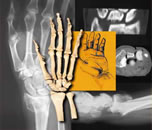


 |
|
|||
(7) What do you think happened? There was an unrecognized volar ulnar fragment, with sagittal and coronal fracture lines that were not visible. The volar ulnar corner was not properly supported and it collapsed. Volar plating with a fixed angle implant has become the most common method of ORIF of these fractures and its popularity and the array of implants has grown exponentially. Our recent series of this topic (Rozental TD, Blazar PE. Functional Outcome and Complications After Volar Plating for Dorsally Displaced, Unstable Fractures of the Distal Radius. J Hand Surg [Am]. 2006;31(3):359-365.), from which this case was taken, highlighted the generally excellent results for this treatment, however we did identify a few complications that are instructive. Our paper reports two individuals who had loss of reduction of the lunate facet, which initially appeared well reduced. The 3D anatomy of the ulnar column of the radius is challenging to understand or to visualize with fluoroscopy. Since identifying this problem, we have particularly been paying attention to the fixation of this specific fragment and tried to use or place 2 screws or pegs to support the ulnar facet fragment(s). Implants that allow only one screw or peg should be avoided, and one should be chosen that allows multiple screws or pegs. Part of the challenge is to properly engage the fragment with one or two screws but at the same time avoid past-pointing the screw tip and running into tendon problems (see this Guest Professor case for an example of this problem). The unstable ulnar corner problem is analogous to the case reported by Neil Harness and Jesse Jupiter with small volar lunate facet problems (J Bone Joint Surg Am. 2004 Sep; 86A-(9), page 1900-8.) in that there is inadequate purchase of buttress of the fragment, leading to late displacement.
For further discussion of complications of volar plates, see this essay.
The patient declined revision surgery, as he was not experiencing any problems. His last followup to our office was at 12 months post surgery. He had a wrist arc of motion of 105 degrees of flexion-extension with no functional limitations. He has returned to playing banjo, but has not returned to ice skating. A check of the computerized records for our medical system showed that he has not seen an orthopedic or plastic surgeon in the last three years, so it would appear that he has continued to do well. |
||||
| About Us | Research | Basic Knowledge | What's New | Forum | Guest Professor | Post a Case | eRadius Conference | Patients | Home |